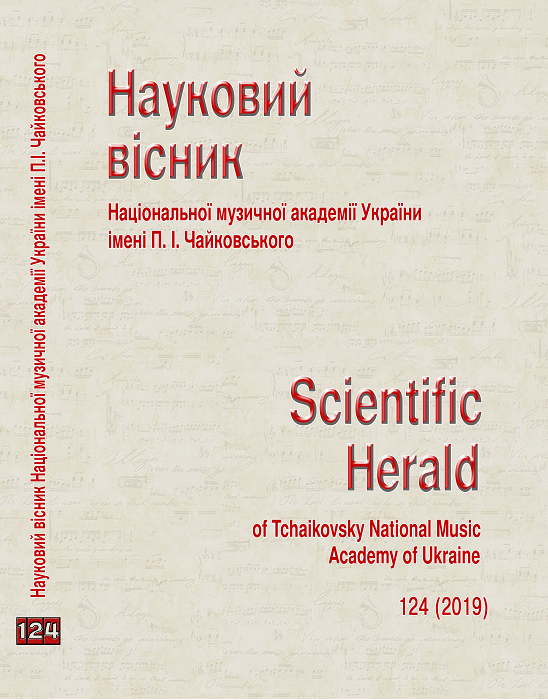The genre of the motet in the Jean-Philippe Rameau's creativity
DOI:
https://doi.org/10.31318/2522-4190.2019.124.165411Keywords:
motet genre, French sacred music of the XVII–XVIII centuries, early period of creativity, J.-Ph. Rameau’s motet "In convertendo"Abstract
The relevance of the article is the need to explore the early period of creativity of J.-Ph. Rameau, represented by the genre of a large motet – one of the most important in French sacred music of the XVII-XVIII centuries. Samples of this genre constitute an important part of the works of A. Dumont, J.-B. Lully, M.-A. Charpentier, M.-R. Delaland and other composers.
Main objectives of the article are to analyze one of the composer’s most famous motets "In convertendo", in the context of the early creative period of J.-Ph. Rameau.
The methodology involves the use of a comparative-historical method (to study the influence of the features of French secular and court music, as well as the cultural policy of Louis XIV on spiritual music), the biographical method (to identify the features and circumstances of the early period of J.-Ph. Rameau) and the genre-style method (to study the specifics of the French motet on the material of "In convertendo").
Results and conclusions. Despite the canonical text, the musical embodiment of the motet "In convertendo" by J.-Ph. Rameau (second edition – 1751) is not fundamentally different from the more famous musical and theatrical works of the composer. In seven sections of the work there is a connection with the stage music of the time. The solo elegiac first and dramatic fourth episodes can be compared to the French air, the trio of soprano, countertenor and bass demonstrates the master's creative approach to the text "lamento", the grandiose second and seventh choral episodes of the motet are accents of the drama of the work. The traits of the lyrical tragedy in the French big motet also appeared in the alternation of independent choral, solo and recitative numbers and in the peculiarities of the musical language, which confirms the idea of the "theatricality" of Louis XIV’s century, which penetrated into spiritual genres. The combination of concert and religious elements in large motets provided favorable opportunities for the expression of sublime spiritual ideas in secular genres.
Downloads
References
Brjanceva, V. N. (1981). Jean Philippe Rameau and the French Drama Theater [Zhan Filipp Ramo i francuzskij dramaticheskij teatr]. Moscow: Muzyka, 303 p. [in Russian].
Voronina, M. (2012). The formation of the oratorio genre in France XVII. in the context of Western European oratorio tradition [Stanovlenie zhanra oratorii vo Francii XVII v. v kontekste zapadnoevropejskoj oratorial’noj traditcii]. Culturology and art studies. Collection of articles. [Kyivske muzykoznavstvo: Kulturolohiia ta mystetstvoznavstvo], vol. 41, рp. 97–111 [in Russian].
Girdlestone, C. (1989). Jean-Philippe Rameau: his Life and Work. New York: Dover Publications inc., 631 p. [in English].
Reeves, A. (2001). Understanding French Baroque performance practice via a modern edition of Jean-Philippe Rameau's «In convertendo». University of Arizona, 221 p. [online]. Available at: https://repository.arizona.edu/handle/10150/298728 [Accessed 14 Jan. 2018]. [in English].
Sadler, G. and Christensen, T. (1988). Rameau, Jean-Philippe. The New Grove French Baroque Masters Grove/Macmillan, [online]. Available at: http://www.musictheory21.com/documents/rameau-studies/rameau-grove-ii.pdf [Accessed 14 Jan. 2018]. [in English].
Downloads
Published
How to Cite
Issue
Section
License
Our journal abides by the CREATIVE COMMONS copyright rights and permissions for open access journals.
Authors, who are published in this journal, agree to the following conditions:
The authors reserve the right to authorship of the work and pass the first publication right of this work to the journal under the terms of a Creative Commons Attribution License, which allows others to freely distribute the published research with the obligatory reference to the authors of the original work and the first publication of the work in this journal.
The authors have the right to conclude separate supplement agreements that relate to non-exclusive work distribution in the form in which it has been published by the journal (for example, to upload the work to the online storage of the journal or publish it as part of a monograph), provided that the reference to the first publication of the work in this journal is included.




